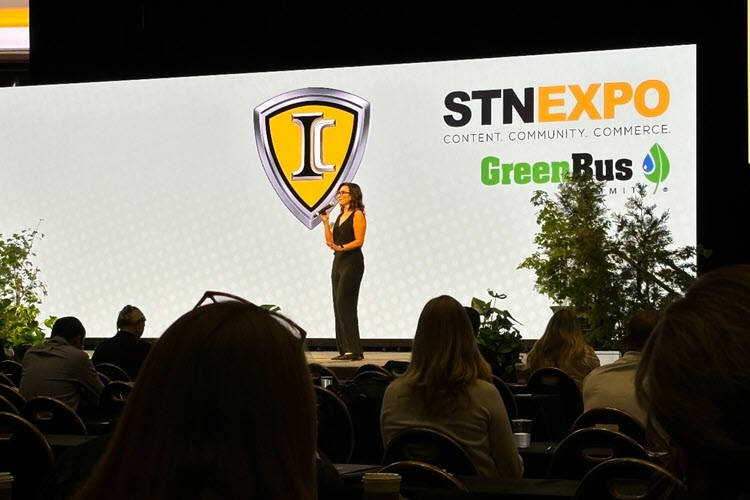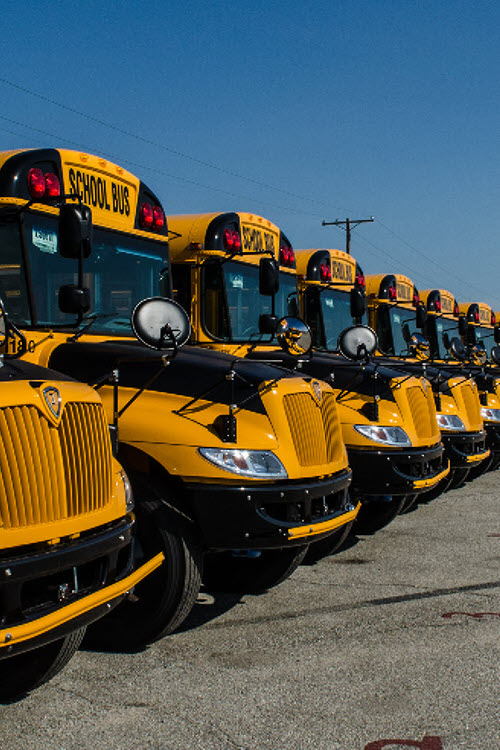250,000 Units Mark Moment in Deep IC Bus History
By Cristina Commendatore, chief editor and content manager, International Motors, LLC
When you “bleed yellow,” big milestones that cement your company’s dedication to the school bus industry are just another day at the office. After 25 years in operation and 250,000 units (and counting) coming from the IC Bus, LLC (IC Bus) Tulsa Bus Plant, the people at IC Bus have a lot to celebrate.
Over the past two-and-a-half decades, the entire IC Bus team — including everyone working at the Tulsa, Okla., plant and within the dealer network — refuse to waiver when it comes to driving continuous customer support. That dedication has prompted market-leading results, as 41% of all school buses on the road in the U.S. and Canada today are an IC Bus™ school bus.
“If you get in the school bus industry and then you get motivated by what we’re doing every day — the safe transportation of our future, our children — you may not want to leave the bus business,” said Charles Chilton, VP and General Manager, IC Bus. “Once it gets in your blood, the saying is you ‘bleed yellow.’ People working in our school bus space are really motivated by more than just a job. That pride carries all the way through our corporate headquarters, through the plant, through the service field, and through our dealer network.”
That level of success and brand equity starts with strategy. Intention. And for IC Bus, integration.
Roughly 30 years ago, Tom Cellitti, former VP and General Manager for what was then Navistar’s Bus Business, saw a lot of waste in bus manufacturing. At the time — and back to the invention of the school bus in the early 1900s — the school bus chassis and body businesses were separate. The chassis was built in a truck chassis plant, with International as the primary supplier. Then, the chassis was shipped to one of various body companies. That process created excess freight, excess costs, and a driver interface that was anything but driver friendly.
“The support was also different,” Cellitti said. “There was a different dealer who supported the body than there was for supporting the cab and the engine. It created a lot of waste.”
“International had 60% of the chassis school bus share when we started looking at this,” Cellitti added. “We felt we were losing contact with the end customer and our ability to really focus on them because the body builder controlled all the customer interfaces for the driver. We knew we had to do something different.”
Cellitti and the team at the time came up with a three-point strategy for the creation of what would be the first integrated chassis — IC — bus company:
- Standing up an integrated conventional bus business (IC Bus) and the product that ended up being the CE Series.
- Building a competitive integrated bus manufacturing business (Tulsa Bus Plant). The team needed the space and capacity to develop and produce a complete and integrated conventional (long nose) bus.
- Putting the customer first by integrating bus-focused distribution. At the time, International was mainly a truck company, but Cellitti and the team recognized the importance of collaborating with the bus end user.
“We developed the new IC Bus by focusing on the customer and getting rid of the waste in the system,” Cellitti said. “The important part of that was being able to make it all in one place.”
The Vision That Sparked Integration
When Cellitti visited what is now the Tulsa Bus Plant, he saw right away that the vacant 2-million-square-foot warehouse had enough parking to accommodate at least 2,000 buses. The site was full of potential.
To sweeten the deal, Tulsa’s director of economic development met Cellitti on-site and presented an offer that seemed impossible to refuse.
“I was just a dumb VP,” Cellitti quipped. “I probably couldn’t commit the company to this, but I shook hands with him and said I would talk to our CEO when I get back to Chicago, but told him, ‘You’re going to have a deal.’ That was the story, and we were so lucky to have the best workforce and total support for our grand opening for our announcement. We had the governor, both U.S. senators, the Congressman, and the Tulsa mayor. They all showed up with customers and dealers for our grand opening in 2001.”
From IC Bus’s inception, pockets of International® dealers were interested in selling buses. International’s extensive network for both bus and truck dealers has only continued to strengthen over the years.
Today, Tulsa is touted as “The School Bus Capital of the World.” And the IC Bus plant produces the best yellow buses from the “Tulsa mile,” an emerald-hued, mile-long assembly floor and the birthplace of more than 11,000 new IC Bus school buses every year.
“Because we had this integrated conventional bus with the promise of International support behind it, the competitive bus dealers knew they wanted an International chassis because we were the best supported for the customer,” Cellitti said. “We created a great distribution network that still exists today, and they support the customer with the International brand promise.”
“When they saw we had a body company, we had to up our game,” Cellitti added. “We improved the body we made for IC Bus. We also incorporated ergonomic improvements because we were building the chassis and the body. That was really what did it.”
Built on a strong foundation
Over the years, IC Bus leadership, plant employees and cross-functional teams at IC Bus have continued to stay the course and commit to the values the brand was founded on.
The team driving IC Bus today is leaner than ever, but highly effective. “We say we are lean and mighty,” Chilton said. “The improvements made by VP Tulsa Plant Manager Rodney Tharp and the Tulsa team are fantastic. Their commitment to building a high-quality product makes a real difference for our customers.”
Building trust and relationships by listening to customers has remained a guiding principle for the IC Bus team. In the spirit of a customer-first mindset, Cellitti and his team made it a point to empower field teams to forego some of the corporate red tape so they could obtain the resources to fix problems quickly and bring technical solutions to support the customer in real time.
“That continues today,” Chilton said. “Our IC Bus field service team is great to work with and remains dedicated to serving our customers. If the call reaches my desk, it’s rare at this point. My line is always open, but the field team and our service team are fantastic at resolving problems, and they’re empowered to make it happen. Our daily mission is making sure that we are able to take care of the customer.”
To further enhance customer efficiency today, connected technology is standard on all IC Bus™ vehicles. Telematics solutions provide tools and resources to help bus fleets and operators maximize uptime and operational efficiency.
“These solutions are starting to pay dividends for our customers’ uptime, and customers are embracing the use of that toolbox and getting into more predictive solutions,” Chilton said. “It is enabling us to work with some of the bigger fleets who want to get down to true cost of operation. Now they are getting the data to show that there are things we can do from maintenance, uptime and connectivity that will effectively help them run at a lower cost per mile as well as making sure the buses are running when they need to run.”
When two drivers meet
When Chilton and Cellitti sit down for a conversation – even in the company of a newcomer – it feels like you’re talking with old friends. Because you are.
Chilton and Cellitti met more than 30 years ago when Chilton was working at a bus body company and Cellitti was at International, selling medium-duty vehicles. Before the consolidation of the bus and chassis companies, the two worked on a joint product between International and the body company to bring a unique product to market.
Later, the two worked together again when Chilton was at an emergency equipment company in Florida and Cellitti was still in the medium-duty truck business. This time, Cellitti came in to sell Chilton on the value proposition of integrating the Diamond Logic® electrical system into a fire truck.
Chilton eventually ended up joining International in 2009, and Cellitti was one of the first to reach out to him.
The two are so passionate about making a quality product for the end user because they both started out in the driver’s seat. Chilton started his career as a school bus driver when he was a senior in high school, while Cellitti worked his way through college driving a truck. They continue to maintain their respective commercial driver’s licenses today.
“I always look at the driver environment,” Cellitti said. “This past summer when I was looking at this latest CE Series bus, I could not believe how well this was executed.”
For every next-generation CE Series bus that comes down the road, there are so many people in the background who have contributed to making this a safer and efficient product for customers and the communities they serve.
“It really was taking the best of what we did with the International® MV™ Series product and bringing that ergonomic environment — which I believe International has the best ergonomics in the medium space — and bringing that performance and functionality to a school bus driver,” Chilton said. “When I ask drivers today what they like about the bus, the first thing they say is they like the driver-dedicated air conditioning system. That was a decision made early on. We weren’t going to market without it. This is 2025, we need to make sure that we are taking care of our drivers.”
Chilton also pointed to driver-performance upgrades that have been made to the steering column as well.
“When the bus driver comes to a stop there are a dozen steps that must happen to come to a safe stop,” Chilton said. “On the steering wheel, there are buttons one, two, three and four so they can semi automate the stopping process, so the driver doesn’t have to think about the steps. It’s an optional feature because not every state allows you to operate that way, but it was something we added to the solutions set so we can take some of those tasks away from the driver’s thinking so they could focus on the kids getting off the bus and crossing the street.”
As he’s come full circle in his career, Chilton is proud to lead IC Bus, which builds more buses in the TRATON GROUP portfolio of products than any other brand within the Group.
Solutions that move the industry forward
The solutions that IC Bus provides today go far beyond product. For instance, with the battery-electric CE Series bus, IC Bus offers full consulting, onboarding, charging, financing and maintenance solutions.
Likewise, all IC Bus products include preventive and more predictive maintenance solutions for customers. When it comes to financing, International® Financial offers competitive captive finance solutions that fit specific customer needs and assist with government and municipality contracts.
“All of it is really coming together and stacking all those offerings to provide the best solutions in the industry,” Chilton said. “School boards are facing cost challenges today. So, not only do we have to bring in safety technology and other solutions, but we have to do it effectively and efficiently.”
For Chilton and the IC Bus team, this 250,000-unit build milestone at Tulsa signifies where the company is today, but it’s only the beginning.
At IC Bus, everything we do begins and ends with our customers. As we look to the future, our mission is to delight them — by listening closely, responding boldly, and delivering safe, smart, and high-impact solutions that truly make a difference.
“The future is bright for IC Bus,” Chilton said. “I am proud to be part of the number one brand in the school bus industry. It’s a great time to be at IC Bus.”









